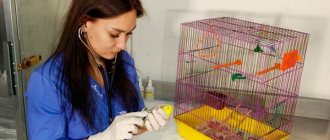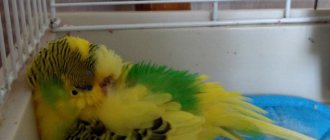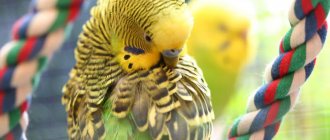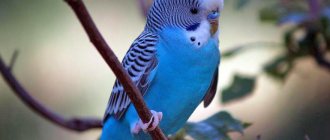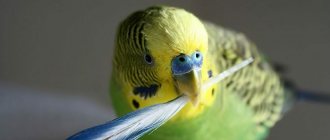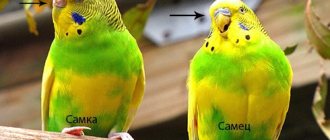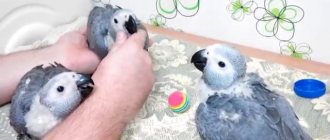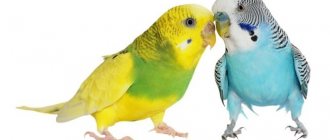What to do if a parrot's cloaca comes out?
Among pets, ornamental birds occupy a special place. The most common family is parrots. Amazing birds delight their owners with the splendor of their colors, playfulness, and ability to copy human speech. To maintain the activity and health of your ward, it is necessary to take proper care of both the bird itself and the aviary. Numerous factors associated with violation of care rules lead to various diseases. In some cases, it happens that the parrot's cloaca has come out. This phenomenon is not uncommon, so both professional breeders and bird lovers should familiarize themselves in advance with the causes of the disease, associated symptoms and methods of treating birds.
Lipoma
If a domestic parrot has a tumor on its belly, it is most likely a lipoma, that is, a tumor formation located at the bottom of the abdomen. Usually this is a benign neoplasm that grows not only on the abdomen, but also on other parts of the bird’s organs. This is a subcutaneous ball that moves when pressed. The malignant formation is practically motionless; vessels are clearly visible on it.
A lump on a parrot's belly can only be treated after visiting a veterinarian. Obesity in exotic birds and poor nutrition lead to the disease. The disease can be stopped if the bird is put on a diet, including more cereals, greens and fruits in its menu.
The bird should be released from the cage as often as possible, at least once a day. There are no special cures for lipoma in the bird of paradise; the disease itself is a common phenomenon. Parrot breeders are trying to normalize lipid metabolism using a drug intended for humans, Legalon 70.
Definition of the cloaca and symptoms of its pathological changes
Parrots are often exposed to diseases occurring in the gastrointestinal tract. In most cases, the cause is poor nutrition and failure to comply with basic standards of proper maintenance and care. Numerous factors can lead to pathological changes within a bird's body. One of the most common symptoms indicating a digestive disorder is a condition where the parrot has a cloaca, or the area is constantly dirty and stained with droppings, in some cases, baldness and inflammation are observed. This phenomenon is quite painful for the bird, so you should start treating your pet as early as possible. Associated symptoms of the disease are:
- Lack of appetite;
- The droppings are not formed into the correct curl;
- Change in color of droppings;
- Ruggedness, disheveledness;
- The bird sits silently and does not fly.
In order to understand the cause of intestinal prolapse, you need to understand what exactly is a parrot's cloaca. Thus, the definition of cloaca implies the terminal part of the digestive system. The appearance is a short but wide piece of intestine that extends outwards. This area includes both the ureters and the oviducts in females, or the vas deferens in males. This part of the intestine is the space where three channels exit. From the first, droppings come out into the cloaca, from the second - urine, from the third - an egg or seed. A small piece of intestine performs several important functions, including mixing feces with urine. It is this part that forms the correct curl of the litter. If a bird's droppings change in consistency or shape, then intestinal disease may be suspected.
Sources of infection
It is impossible to rule out infection of a bird from a tick bite. Veterinarians identify the following sources of infection:
- Poor living conditions, non-compliance with the rules of basic hygiene and nutrition, lack of care on the part of the owner.
- You can buy an already infected pet. The probability increases if there are many birds in the cage and among them there are sick ones.
- Grain mixture of low quality or expired, damaged by fungus and mold.
- New plaid accessories that have not been heat treated. Toys that have been used or donated by the owners of another parrot pose a high risk.
- The presence in the house of bouquets or compositions of tree branches and shrubs that may contain parasites.
- Contact with an infected parrot during mating.
- Exceptional cases include the “transportation” of ticks on the soles of shoes.
Causes of bowel prolapse
Various diseases occurring in the intestines or genitals can lead to pathological changes in the cloaca. If a parrot's intestines come out, the following factors may be the cause:
- Incorrect feeding. This aspect includes monotonous food, lack of nutrients and vitamins, poor quality food, processed or prohibited foods;
- During the laying of an egg, females may lose their cloaca. This phenomenon occurs when a parrot lays eggs too often, as well as when there is a deficiency or excess of calcium and vitamin E;
- The formation of a tumor in a small organism pushes the intestine out.
If it has been recorded that the parrot’s intestine has come out and is hanging between its legs like a ball, then it is necessary to urgently take measures to save the pet. The work of a qualified ornithologist is required. As first aid, you should remove droppings that fall on the prolapsed cloaca and prevent it from drying on the organ. This can lead to tissue necrosis.
Classification of parasites
The danger of a tick is that it exists for a long time without noticeable symptoms. A single focus of itching will not bother the bird much, but after viral bodies enter its blood and its immunity decreases, the parasite will begin to multiply.
Types of parasites:
Scabies One of the common types of parasites, it settles in the upper layers of the parrot's skin. The principle of infection is that the produced toxins are placed in the bite area and the bird is infected.
Feathered Has a small flattened body. It eats away at the skin and drinks the blood and lymph that appears on the surface of the epidermis after the bird scratches or gnaws itself in the hope of getting rid of the itch.
Tracheal Lives in the internal respiratory organs, where it makes a nest. After laying the larvae, the female crawls into the upper respiratory tract, and the male continues to infect the lungs of the bird.
Syringophilosis The parasite settles at the edge. The parasite feeds on lymph and gradually infects new feathers. Actively breeding.
Methods for solving the problem
To alleviate your pet's condition, you should do the following:
- treat the prolapsed intestine with chlorhexidine solution or fresh chamomile decoction;
- After washing, Levomekol or Tetracycline ointment is applied. Mixing 1:1 of Levomekol and Traumeel is allowed;
- try to put the intestine back into place yourself, if necessary, entrust the work to a specialist;
- after reduction, apply a piece of ice to the cloaca ring several times a day to strengthen muscle tone;
- a few drops of Vaseline oil are poured into the beak (taken until the loss stops);
- a little honey is added to drinking water to increase vitality;
- Only soft foods - porridge - are allowed as food.
The above actions will alleviate the parrot’s condition and restore its vitality. In severe cases, treatment with antibiotics prescribed by a doctor is required. Timely treatment will prevent complications and prevent the death of your pet.
Inflamed goiter
If a parrot’s goiter is clearly visible, for example, as in the photo, then inflammation occurs, although for a long time the disease in wavy birds is asymptomatic. The causes of the disease are:
- toxic substances that birds often inhale;
- poor quality food and lack of vitamins;
- poorly purified water;
- complications after infections.
The exotic bird begins to peck food poorly, lethargy appears, and the drinking regime is disrupted. Over time, vomiting appears, in which mucous impurities are present, and the goiter sac itself is inflamed. This is a source of infection and the result of fermentation and stagnation. In severe cases, it sags and turns blue.
The disease should be treated exclusively by a doctor. Only a specialist knows how budgies get sick and how to eliminate the ailment. With severe swelling and sagging crop, in some cases the sick bird most often cannot be saved. At the initial stages, the doctor washes the goiter with a 2% tannin solution.
Causes of inflammation of the cloaca
Inflammation of the cloaca occurs as a result of:
- improper feeding: ingestion of difficult-to-digest food by the bird, blockage by foreign objects, disruption of the stomach and intestines after ingesting a large amount of gravel,
- lack of vitamins A, B, E, microelements,
- decreased tone of the intestinal muscles with excess weight,
- paralysis of the intestines as a result of pressure on it from tumors in nearby organs,
- blockage caused by difficulties in the process of egg formation and egg release, especially in young birds,
- neoplasms in the cloaca itself, which in most cases are malignant.
Treatment and prevention
Depending on the cause of the disease, the doctor prescribes treatment for the parrot. Therapy begins with improving the condition of the inflamed organ and preventing intestinal blockage. To do this, a mixture of any vegetable oil and sterile water in a 1:1 ratio is injected into the cloaca using a catheter. External treatment of the affected mucosa with oxytetracycline or furatsilin ointment is carried out regularly for five days.
Among medicinal herbs, marshmallow root helps relieve inflammation. You can give your parrot a teaspoon of decoction twice a day (boil 10 grams of dry raw material in a glass of water for 20 minutes, leave) or dry powder on bread crumb (single dose 0.1 grams). Positive results are obtained by using drugs that include burnt magnesia, ferrous sulfate and glycerin. In particularly difficult cases, the use of antibiotics is allowed, but they can only be prescribed by a doctor after a thorough diagnosis of the causes of inflammation of the cloaca in a budgie. Treatment should be carried out in parallel with the development of proper nutrition for the sick bird.
To prevent inflammation of the cloaca, a sufficient amount of greens and mineral feed should be included in the bird's diet. It is necessary to ensure that your budgie always has a sufficient amount of good quality drinking water.
Budgerigar cloacitis is not contagious unless caused by pathogenic intestinal microflora. This variant of the disease can be excluded only after a certain laboratory examination by a specialist.
Background information about the disease Cloacitis (parrots): description, symptoms, signs, diagnosis, treatment of pets
Kind of animal:
Description of the disease:
Inflammation of the cloaca due to intestinal dysfunction.
Causes of the disease
Poor quality food - blockage with foreign objects, intestinal dysfunction after ingesting large amounts of gravel, sand or blockage with fibrinous masses, in case of obesity of the bird and intestinal paralysis, in young females - irritation of the mucous membrane of the cloaca with an ejected egg, etc.
Symptoms of the disease
Emaciation, the plumage around the cloaca is dirty due to exudate, the cloacal ring is swollen. There may be neoplasms of the cloaca. Apathy, shortness of breath, increased thirst. Diarrhea with blood in the feces.
Diagnosis of the disease
Based on anemnesis and clinical signs.
Treatment of the disease
Marshmallow root decoction - 10:200 (teaspoon) or marshmallow root powder (add to the crumb at the rate of 0.1 g of powder per dose). Quite good results in parrots were obtained from the use of pills which contain: iron sulfate - 150 g, burnt magnesia - 2.5, glycerin - 1.5 g. This procedure is performed 2-3 times a day. In addition, some sources suggest the following scheme: if the cause of cloacitis is constipation, then first you need to free the cloaca from feces. Then the anus and the area adjacent to it are irrigated with fresh warm urine, the affected area is carefully wiped with a cotton swab, also soaked in urine, and lubricated with a 3% aqueous solution of mumiyo. This is done until the signs of the disease disappear. It is also recommended to give mumiyo to a sick bird (at the rate of 0.4 mg per 100 g of body weight), in the morning, half an hour before feeding, for 10 days.
Diseases by animal species Need money before payday?
more than 30 services
Online loans to a card in 15 minutes
The 2 year old loves to throw. Look what happened when his parents bought him a basketball hoop!
Hello!! My budgie is 6 years old. Recently I came across a problem - in my little town there are absolutely no bird specialists. Accordingly, that’s why I’m writing to you. He was sick for a month. Before his illness, he was active, flew everywhere, chirped loudly, friendly, completely healthy in appearance. Except that the paws and tongue were bluish. Daily diet: WAKA food, plus lately I’ve been constantly eating whatever I find on the kitchen table, even when I saw a plate, he flew up and ate with me (I used to think it was normal and the bird itself knows what to eat. Now I understand what it is erroneous opinion.) About a month ago he fell ill: he regurgitated a lot of food with mucus, then he began to diarrhea and become weaker. He became lethargic and indifferent. He constantly scratches the cloaca, it is inflamed, the droppings are drying up, the feathers are plucked, everything around is red and swollen. The droppings are liquid and unnaturally bright green in color. I took them to the doctor. The doctor honestly did not admit that she doesn’t understand much about birds and prescribed Baytril and Dixafort. It didn’t help, the bird weakened before our eyes. Her legs began to weaken, she couldn’t sit on the perch, she was freezing. Within 2 weeks I was taken to another clinic. They said that Dexafort is a very strong medicine, and I only made the parrot worse. They gave me an injection: Zinalrim or something (0.1 ml in saline solution). They prescribed Metronidalol every 8 hours for at least 7 days, Kamedol 0.1 ml in the beak for 7 days (I think that’s the name of the drug, I can’t make out the doctor’s handwriting). Smecta 3-4 times a day. Radostin Antistress. Heating by lamp around the clock. Do you think the prescribed treatment for the situation is adequate? They didn’t say anything about treating the cloaca, but I read on the Internet that this must be done. They write that you need to administer Tetracycline ointment. Tell me, should I enter it and if so, how? And in general, how to treat it in order to relieve inflammation as soon as possible? The bird is suffering... Help, please. I'm attaching a photo of my butt. When I took a photo, I noticed that there was a little blood there. By the way, a feather hasn’t fallen out of his tail for a long time. Usually, when the new one grew, he pulled out the old one. And now it has long been a tail of 2 blue feathers. Is it okay? Species, Age, sex of the parrot: wavy, 6 years old, male How it is kept (singly or in pairs) alone Diet of the bird (what food do you feed (name), what mineral supplements - does the bird eat them, do you give vitamins - what, how often, in what dosage, what additional food, supplements, treats do you give, what kind of drinking water and other drinks, etc.) Previously - Rio, the last three cans - VAKA, Minerals - more recently - RIO, eats them very rarely, water - filtered, treats - sometimes sticks for parrots Did the bird eat food from the human table, indoor plants, or other prohibited foods Did it constantly eat from the table, ate salt often? Describe the conditions of detention (the room where the bird is kept - kitchen, room, balcony, etc. .) Cage or free keeping Room, cage, door is constantly open How the bird was kept before it came to your home (singly or in pairs, what kind of food, was it sick or not, etc.) in the store How long has the bird been with you 6 years Has it been sick you had a bird before (if “Yes”, then with what, how they were treated, with what drugs, in what dosage, etc. What were the results of the treatment?) About two years ago I had an attack of shaking, sneezing and watery eyes. The vet said it was heart failure. I prescribed mildronate. The attack was a one-time event. Has the litter changed now? The diarrhea is the problem that worries you now (symptoms)? How long ago did this problem appear? Diarrhea, inflammation of the cloaca. Four weeks. The reasons that in your opinion (or the exact ones) influenced the occurrence of the problem? (for example, “scratched by a cat”, “ate a houseplant”, “hit”, “got a cold”, “stress”, “shedding”, “change of food”, “food poisoning, dangerous metals that smell strongly of you”, “ foreign body”, “contact with other birds, cats, rodents or other animals.”, etc.) I suspect a change in food. Or ate something. He flew everywhere, often ate from the floor... Were aerosols sprayed in the room, were there any strong odors of various origins (repairs, polishes, household chemicals, perfumes and other volatile or strong-smelling substances) no What city are you from? Have you consulted a doctor? What did he advise you? Have you made an appointment for testing? Kemerovo. I consulted. Metronidazole was prescribed. Tests for helminths, psittacosis, coccidiosis are negative. Everything you can describe in addition...
Causes of cloacitis
The mucous membrane of the cloaca becomes inflamed for various reasons, but the most common are poor nutrition and the absorption of foreign objects.
In more rare cases, the problem develops due to the consumption of large amounts of sand and gravel.
With excess weight, the intestinal muscle tissue loses tone, and in advanced stages paralysis occurs.
In young individuals, the inflammatory process is a consequence of irritation of the cloaca during the release of the egg.
Another provoking factor is pathogenic microflora.
Content
- The causative agent of parasitic infection is pinworm
- Causes of pinworm infection
- What complications does the disease cause?
- Symptoms of the disease Acute period
- Chronic stage
Enterobiasis is an infection of the body with helminths - pinworms. Young children are at risk, but children of other ages can also be infected.
Symptoms
The main clinical manifestation is rapid weight loss.
Visual inspection shows a high degree of contamination of the feather cover, especially in the area of the cloaca, since a large volume of secretion is released.
The cloacal ring is swollen and hypertrophied. During normal development in birds, droppings have the consistency of dense lumps, they are white in the center and green at the edges.
Diarrhea results in the passage of watery stool, sometimes with traces of blood.
The parrot's general health is worsened by shortness of breath, complete apathy, lack of appetite, and increased thirst.
Diagnostics
The specialist examines the appearance and internal changes. In the first case, he collects anamnesis and examines the feather cover.
The second is based on the use of instrumental and laboratory methods. White lesions are found in the intestines, liver and spleen.
They have serious diagnostic value, since pathogens cannot always be identified in stool samples.
The disease manifests itself quickly enough, and the owner will be able to promptly pay attention to suspicious symptoms and consult a doctor.
Treatment
Therapeutic measures depend on the cause that caused the disease. If there is a lack of gravel in the diet, the bird is given olive, castor or paraffin oil orally through a pipette.
Additionally, Glauber's and Carlsbad salts are diluted into the water in a ratio of 1 to 200.
A decoction based on marshmallow root or marshmallow root powder shows excellent results.
The diet must be adjusted; the menu is filled with healthy fruits, vegetables and herbs.
Ornithologist comes to your home around the clock
The specialist conducts diagnostics and, based on it, draws up an effective treatment plan.
The parrot must be sent to a veterinary clinic for an appointment, but for this you will have to purchase a special box, and long-term transportation causes psycho-emotional stress, which causes a number of complications.
In this case, it is recommended to call a doctor at home, because the service has the following advantages:
- High response speed.
- No need for transportation.
- Carrying out a complete diagnosis.
- Drawing up an individual treatment plan.
- Affordable cost of services.
A call to a health worker in Moscow and the Moscow region can be made by phone or through a special form on the website. The average arrival time is 90 minutes.
Possible complications
Diseases of the cloaca require immediate attention to a veterinary hospital, as they pose a real threat to the lives of birds.
As a preventative measure, the parrot needs nutritious food and vitamins, keep the cage clean, and also undergo regular examinations with a doctor in order to timely diagnose tumors.
Call an ornithologist to your home around the clock
Where to go if your pet urgently needs help? Call our clinic and invite a doctor to your home.
Ornithologists are ready to come to you at any time of the day and provide the necessary support.
At home, you can not only conduct an examination, but also take tests, select therapy and evaluate the diet and quality of living conditions.
What is a parrot's cloaca?
The cloaca is the final part of the digestive system of all birds. It is a short and fairly wide segment of the intestine with an exit to the outside. In addition to the rectum, the ureters and oviducts (in females) or vas deferens (in males) exit into it.
The cloaca resembles a corridor in which, in addition to the exit, there are 3 more doors: feces come out of one, urine comes out of the other, and a seed or a ready-made egg comes out of the third. This small organ is very functional: urine and feces are mixed and excreted in it, and mating also takes place here.

